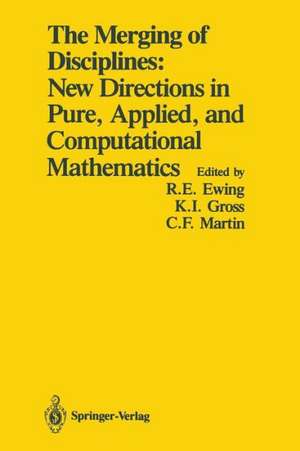The Merging of Disciplines: New Directions in Pure, Applied, and Computational Mathematics: Proceedings of a Symposium Held in Honor of Gail S. Young at the University of Wyoming, August 8–10, 1985. Sponsored by the Sloan Foundation, the National Science Foundation, and Air Force Office of Scientific Research
Editat de Richard E. Ewing, Kenneth I. Gross, Clyde F. Martinen Limba Engleză Paperback – 3 oct 2011
Preț: 384.70 lei
Nou
Puncte Express: 577
Preț estimativ în valută:
73.61€ • 76.86$ • 60.92£
73.61€ • 76.86$ • 60.92£
Carte tipărită la comandă
Livrare economică 04-18 aprilie
Preluare comenzi: 021 569.72.76
Specificații
ISBN-13: 9781461293859
ISBN-10: 1461293855
Pagini: 236
Ilustrații: XVI, 214 p.
Dimensiuni: 155 x 235 x 12 mm
Greutate: 0.34 kg
Ediția:Softcover reprint of the original 1st ed. 1986
Editura: Springer
Colecția Springer
Locul publicării:New York, NY, United States
ISBN-10: 1461293855
Pagini: 236
Ilustrații: XVI, 214 p.
Dimensiuni: 155 x 235 x 12 mm
Greutate: 0.34 kg
Ediția:Softcover reprint of the original 1st ed. 1986
Editura: Springer
Colecția Springer
Locul publicării:New York, NY, United States
Public țintă
ResearchDescriere
This volume is the Proceedings of the symposium held at the University of Wyoming in August, 1985, to honor Gail Young on his seventieth birthday (which actually took place on October 3, 1985) and on the occasion of his retirement. Nothing can seem more natural to a mathematician in this country than to honor Gail Young. Gail embodies all the qualities that a mathematician should possess. He is an active and effective research mathematician, having written over sixty pa pers in topology, n-dimensional analysis, complex variables, and "miscellanea." He is an outstanding expositor, as his fine book Topology, written with J. G. Hocking (Addison Wesley, 1961), amply demonstrates. He has a superlative record in public office of outstanding, unstinting service to the mathematical community and to the cause of education. But what makes Gail unique and special is that throughout all aspects of his distinguished career, he has emphasized human values in everything he has done. In touching the lives of so many of us, he has advanced the entire profession. Deservedly, he has innumerable friends in the mathematical community, the academic community, and beyond.
Cuprins
Computer Graphics Applications in Geometry: “Because the light is better over here”.- Modelling and Algorithmic Issues in Intelligent Control.- Global Observability of Ergodic Translations on Compact Groups.- Mathematical Modeling and Large-Scale Computing in Energy and Environmental Research.- Symbolic Manipulation.- Some Unifying Concepts in Applied Mathematics.- Teaching and Research: The History of a Pseudoconflict.- Stochastic Population Theory: Mathematical Evolution of a Genetical Model.- Combinatorics and Applied Mathematics.- Applied Logic.- Pure and Applied Mathematics from an Industrial Perspective.- Letter Values in Multivariate Exploratory Data Analysis.- Newton’s Method Estimates from Data at One Point.- Error Bounds for Newton’s Method under the Kantorovich Assumptions.- Panel Discussion: Implications for Undergraduate and Graduate Education in Mathematics.- Epilogue.














